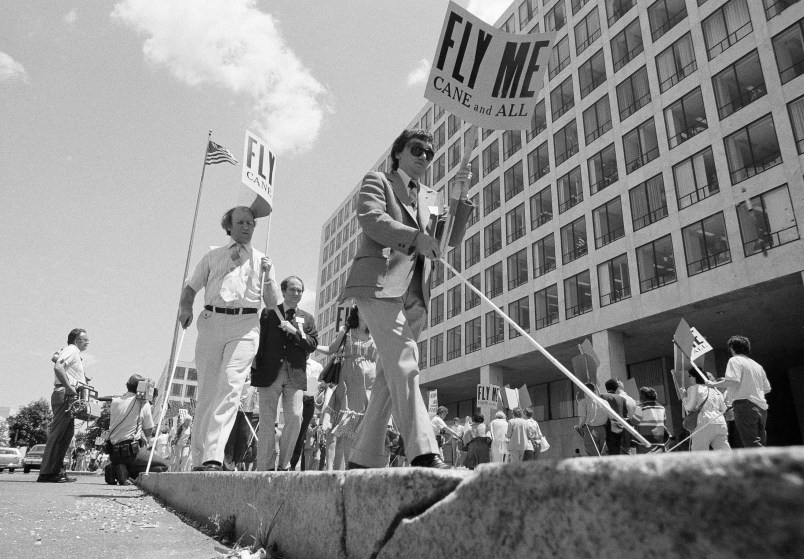Twenty-five years ago this past Sunday, the Americans with Disabilities Act (ADA) was signed into law. Today, people with disabilities are less likely to be employed than they were before the law was enacted. Workers with disabilities earn, on average, about $14,000 less than similar workers without disabilities. About one in every three disabled Americans lives in poverty.
When George H.W. Bush signed the ADA into law in 1990, hopes were high for a revolutionary improvement in the lives of people with disabilities. What can explain this law’s colossal failure?
The problems began decades before the bill was signed. In 1971, Representative Charles Vanik and Senator Hubert Humphrey tried to amend the Civil Rights Act of 1964 to include people with disabilities—but they met immediate resistance. Many politicians, employers and even some activists saw discrimination based on disability as different than discrimination based on race or gender.
As a result, disability rights developed on a separate track from civil rights. Compared to civil rights law, the ADA and laws like it provide different—and weaker—anti-discrimination and equal rights protections for people with disabilities.
The challenge came from business. Critics of the ADA saw disability rights legislation as a form of redistribution in which employers would have to make “special efforts” for some individuals.
The U.S. Chamber of Commerce and the National Federation of Independent Business and other powerhouse lobbying groups strongly opposed the law on the grounds that it would create expensive burdens for corporations.
To appease business interests, the ADA limits the rights of people with disabilities to claim fair treatment. Fairness is not the standard of the law. Employers are required only to offer a “reasonable accommodation” to people with disabilities and businesses are protected from needing to suffer “undue hardship” in their efforts to treat people with disabilities fairly. With these phrases in the law, corporate litigators were off to the races.
As a result, most disability cases resulted in settlements or never made it beyond the very first judicial question, called standing. Unlike women and racial minorities in civil rights cases, the burden in ADA cases lays completely on the plaintiffs (people with disabilities) to prove they are members of a disadvantaged group.
Employers came to see the Supreme Court as an effective tool in undermining the ADA. Ironically, while the Court has frequently played a favorable role in fighting race and gender-based discrimination (and, more recently, has supported equal marriage rights for same-sex couples), the justices have ruled frequently against the claims of people with disabilities. Sociologist Michelle Maroto and I analyzed disability-related federal court cases between 1990 and 2010 and found that the Supreme Court overturned a significant number of lower court decisions that favored disabled plaintiffs.
By 2006, the train had run so far off the rails that supporters of equal rights for people with disabilities offered a new bill, the “Americans with Disabilities Act Restoration Act.” Elements of that bill became law as the ADA Amendments Act of 2008. In his testimony, former Attorney General Dick Thornburgh explained how the courts had eviscerated the original law, saying, “Clearly this is not what was intended by those who worked together cooperatively in the years leading up to ADA passage in 1990. In fact, it is quite the opposite.”
Again though, the U.S. Chamber of Commerce spoke out in opposition. The Chamber of Commerce pointed to legal precedent, in which disability rights are different than other civil rights. They argued that “Congress recognized that the unique aspects of discrimination against individuals with disabilities required legislation that would be distinct from other civil rights statutes that preceded it.”
Seven years after the ADA Restoration Act, we have seen little improvement in the economic wellbeing of people with disabilities. In 2012, the employment rate among people with disabilities was an abysmal 18 percent.
The time has come to give Americans with disabilities full inclusion in the Civil Rights Act. This is what legislators working in the area of disability originally envisioned and sought repeatedly to achieve especially following the outcomes of litigation. True, when it comes to education and employment, people with disabilities sometimes face challenges that are distinct from members of other minority groups. Yet, the failures of the ADA are manifest in the reduced life chances of millions of Americans living with disabilities. Having a separate policy and enforcement mechanism reinforces the idea that disabled people are different and should be seen differently by the law. What has developed is a separate and unequal policy system where the rights of people with disabilities are interpreted far differently than the rights of other disadvantaged groups.
David Pettinicchio is an assistant professor of Sociology at the University of Toronto and the author of numerous articles and essays on social inequality and disability. He is a member of the Scholars Strategy Network.







“In 2012, the employment rate among people with disabilities was an abysmal 18 percent.”
There are many reasons for this. The law has, until quite recently, worked against many poor disabled who wanted to rise out of poverty. Commuter options for those unable to drive are insufficient. Some employers fear the cost to accommodate will be burdensome or that they will be sued. Other employers don’t want to be bothered with accommodating anybody, and still others are located in inaccessible venues. Job training programs do not always accommodate the disabled, either. I’ll stop there, as I think I’ve made my point.
None of this is going to rapidly change just because the disabled get included in the Civil Rights Act. Heck, the people who ARE included under it still experience a myriad of problems.
I agree it’s a laudable goal, but the author does not provide a road map for getting it to happen nor does he address all the work that would still remain to be done afterwards. If he has ideas, they would be worth expressing.